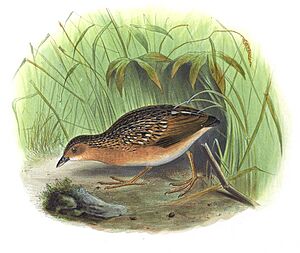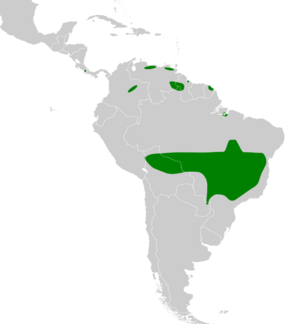Ocellated crake facts for kids
Quick facts for kids Ocellated crake |
|
|---|---|
 |
|
| Conservation status | |
| Scientific classification | |
| Genus: |
Micropygia
|
| Species: |
schomburgkii
|
 |
|
The ocellated crake (Micropygia schomburgkii) is a small bird that lives on the ground. It belongs to the Rallidae family, which includes rails and crakes. This bird lives in grassland and savanna areas of Central America and South America. It's not often seen, but you can spot it by its cinnamon-colored feathers with black and white spots.
Contents
What is the Ocellated Crake?
The ocellated crake is a small bird, usually about 16.5 centimeters (about 6.5 inches) long. Male crakes are a bit heavier, weighing around 40 grams (1.4 ounces), while females weigh about 24 grams (0.8 ounces). This difference in size between males and females is called sexual dimorphism.
What Does the Ocellated Crake Look Like?
The ocellated crake has mostly cinnamon-colored feathers on its face, chest, and belly. Its wings, the back of its neck (nape), and tail are a darker brown. The top of its head (crown) has a more orange color. Some people think the crown's color might also be different between males and females.
You might also see some cream or white feathers on its throat and underparts. The back of its neck, back, wing feathers, and rump have special white spots. Each of these spots has a black ring around it, making them easy to recognize.
The crake's eyes are red, and its beak is yellowish-green. The top part of its beak has some black on it.
Ocellated Crake Subspecies
There are two main types, or subspecies, of the ocellated crake:
- M. schomburgkii schomburgkii: This is the main subspecies. It lives in Costa Rica, eastern Colombia, southern Venezuela, Suriname, French Guiana, Guyana, and northern Brazil.
- M. schomburgkii chapmani: This subspecies lives further south and is larger than the main one. It is found in central and southeastern Brazil, southeastern Peru, northeastern Paraguay, and Bolivia. This subspecies has lighter underparts and more orange-brown feathers instead of cinnamon. It also has fewer of the black and white spots, and the black rings around the spots are thinner.
Where Do Ocellated Crakes Live?
Ocellated crakes are found in many different places, mostly in South America. Their range also reaches into Central America. You can find them in countries like Costa Rica, Colombia, Venezuela, Paraguay, Brazil, Bolivia, Peru, Suriname, French Guiana, and Guyana. Recently, a group was also found in Argentina.
It used to be hard to find these birds because they are small and live in thick habitats. Also, their calls sounded similar to other birds. But now, with better recordings and ways to listen for their unique sounds, we know more about where they live.
What is the Ocellated Crake's Habitat?
Ocellated crakes live in open grassland and savanna areas. They especially like places with tall, thick grasses that are a meter (about 3 feet) or more high. They can live in both dry areas and wetter, flooded ones, but they are seen more often in dry habitats.
These grasslands often grow after big events like wildfires or human activities that change the land. The types of grass in their habitat can be different depending on the region. For example, in parts of Brazil, they live in dry grasslands with Tristachya leiostachya grass. In Argentina, they were seen in dry grasslands with Sandysoil Indiangrass (Sorghastrum setosum) and Little Bluestem (Schizachyrium microstachyum).
These birds can live in habitats as high as 1,700 meters (about 5,577 feet) above sea level.
How Do Ocellated Crakes Behave?
Because they live in thick grass, ocellated crakes are rarely seen out in the open. They mostly move by running through the grass. They also use tunnels dug by small animals like rodents. If a predator comes near, they fly low and close to the ground for a few meters before dropping back into the plants to hide. They have also been seen flicking their tails when they are excited.
Ocellated Crake Vocalizations
The most famous sound the ocellated crake makes is its song, which is called a trill. This trill is a series of loud "pr pr pr" notes that last between 20 and 30 seconds. The sound starts low and gets higher, then stays steady.
Sometimes, after the trill, the crake will make a series of "crying" notes. These sounds are rougher and longer, like "pjrrr" or "prrrxzzz". This mix of trilling and crying notes helps tell them apart from other birds. Sometimes, they only make the crying notes.
Unlike some other crakes that sing duets (two birds singing together), the ocellated crake sings its trill alone. Its solo trill has a slower note rate compared to duet songs.
Another sound you might hear from the ocellated crake is its alarm call. This call has been described as sounding like oil sizzling in a frying pan or a whirring sound. Both male and female crakes make this alarm call, but males make a longer series of calls. Ocellated crakes call most often during sunrise and sunset.
What Do Ocellated Crakes Eat?
The ocellated crake finds its food on the ground. Its diet mainly includes insects. They eat different kinds of insects, such as beetles (like ground beetles and scarab beetles), stoneflies, grasshoppers, cockroaches, and ants.
Ocellated Crake Reproduction
The time of year when ocellated crakes breed depends on where they live. In Brazil, they breed between October and March. In Costa Rica, they are thought to breed during the rainy season, which is from May to November.
The ocellated crake is a monogamous species, meaning a male and female usually stay together for breeding. Their nests are made from dry grass and are shaped like a dome with an opening for them to get inside. The eggs are a dull white color and are about 25 by 19 millimeters (about 1 by 0.75 inches). The female bird sits on the eggs to keep them warm until they hatch.
Images for kids



